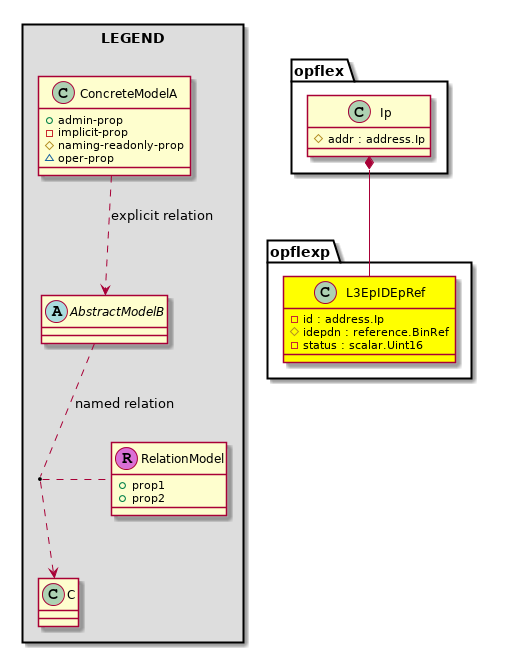| Properties Summary |
| Defined in: opflexp:L3EpIDEpRef |
|
address:Ip
|
id (opflexp:L3EpIDEpRef:id)
An object identifier.
|
|
reference:BinRef
|
idepdn (opflexp:L3EpIDEpRef:idepdn)
The distinguished name of the endpoint discovered over the opflex channel that was triggered from an opflex device.
|
|
scalar:Uint16
|
status (opflexp:L3EpIDEpRef:status)
The upgrade status. This property is for internal use only.
|
| Defined in: mo:TopProps |
mo:ModificationChildAction
scalar:Bitmask32
|
childAction (mo:TopProps:childAction)
Delete or ignore. For internal use only.
|
|
reference:BinRef
|
dn (mo:TopProps:dn)
A tag or metadata is a non-hierarchical keyword or term assigned to the fabric module.
|
|
reference:BinRN
|
rn (mo:TopProps:rn)
Identifies an object from its siblings within the context of its parent object. The distinguished name contains a sequence of relative names.
|
| Defined in: mo:Resolvable |
mo:Owner
scalar:Enum8
|
lcOwn (mo:Resolvable:lcOwn)
A value that indicates how this object was created. For internal use only.
|
childAction
Type: mo:ModificationChildAction
Primitive Type: scalar:Bitmask32
Units: null
Encrypted: false
Access: implicit
Category: TopLevelChildAction
Comments:
-
Delete or ignore. For internal use only.
| |
| Constants |
| deleteAll |
16384u |
deleteAll |
NO COMMENTS
|
| ignore |
4096u |
ignore |
NO COMMENTS
|
| deleteNonPresent |
8192u |
deleteNonPresent |
NO COMMENTS
|
| DEFAULT |
0 |
--- |
This type is used to
|
|
dn
Type: reference:BinRef
Units: null
Encrypted: false
Access: implicit
Category: TopLevelDn
Comments:
-
A tag or metadata is a non-hierarchical keyword or term assigned to the fabric module.
id
Type: address:Ip
Units: null
Encrypted: false
Access: implicit
Category: TopLevelRegular
Comments:
-
An object identifier.
idepdn
Type: reference:BinRef
Units: null
Encrypted: false
Naming Property -- [NAMING RULES]
Access: naming
Category: TopLevelRegular
Comments:
-
The distinguished name of the endpoint discovered over the opflex channel that was triggered from an opflex device.
lcOwn
Type: mo:Owner
Primitive Type: scalar:Enum8
Units: null
Encrypted: false
Access: implicit
Category: TopLevelRegular
Comments:
-
A value that indicates how this object was created. For internal use only.
| |
| Constants |
| local |
0 |
Local |
NO COMMENTS
|
| policy |
1 |
Policy |
NO COMMENTS
|
| replica |
2 |
Replica |
NO COMMENTS
|
| resolveOnBehalf |
3 |
ResolvedOnBehalf |
NO COMMENTS
|
| implicit |
4 |
Implicit |
NO COMMENTS
|
| DEFAULT |
local(0) |
Local |
NO COMMENTS
|
|
modTs
Type: mo:TStamp
Primitive Type: scalar:Date
Units: null
Encrypted: false
Access: implicit
Category: TopLevelRegular
Comments:
-
The time when this object was last modified.
| |
| Constants |
| never |
0ull |
never |
NO COMMENTS
|
| DEFAULT |
never(0ull) |
never |
NO COMMENTS
|
|
rn
Type: reference:BinRN
Units: null
Encrypted: false
Access: implicit
Category: TopLevelRn
Comments:
-
Identifies an object from its siblings within the context of its parent object. The distinguished name contains a sequence of relative names.
status
Type: scalar:Uint16
Units: null
Encrypted: false
Access: implicit
Category: TopLevelStatus
Comments:
-
The upgrade status. This property is for internal use only.

